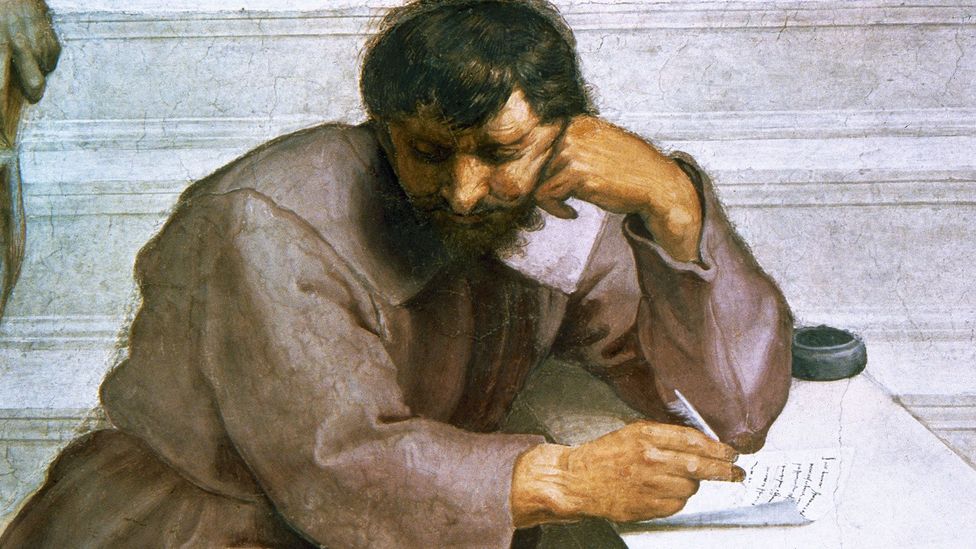An inkpot lost in the crowded fresco The School of Athens could reveal what Raphael hoped to achieve, writes Kelly Grovier.
I
In art, it’s always the little things. Take The School of Athens by the Italian High Renaissance master Raphael, whose death 500 years ago in 1520 is currently being commemorated around the world by major exhibitions and displays from Milan to London, Berlin to Washington DC. Millions of eyes have marvelled at the eternal gathering of ancient philosophers and mathematicians, statesmen and astronomers that Raphael luminously imagines in his famous fresco. Yet it would seem that a small detail near the centre foreground of the painting, from which the true meaning of the masterpiece arguably spills, has gone almost completely unnoticed by historians and critics for half a millennium.
More like this:
– The secret toilet humour in a Titian painting
– The tragedy of art’s greatest supermodel
– The images that fought Fascism
Look closely, and there beside the left arm of the melancholic writer who sits near the middle of the painting, a simple ink pot teeters precariously on the corner of a large marble block, an elbow-twitch away from falling, shattering, and opening a black hole at the heart of Raphael’s work. That unassuming object, and it alone, transforms Raphael’s fresco from being a two-dimensional tribute to rational thought to a far deeper and more mercurial meditation on the mysteries of existence. To understand how that object functions symbolically, we must remind ourselves why Raphael undertook the fresco in the first place, where it sits in the Vatican’s lavish labyrinth of corridors and chambers, and what, on its face, the painting purports to portray.
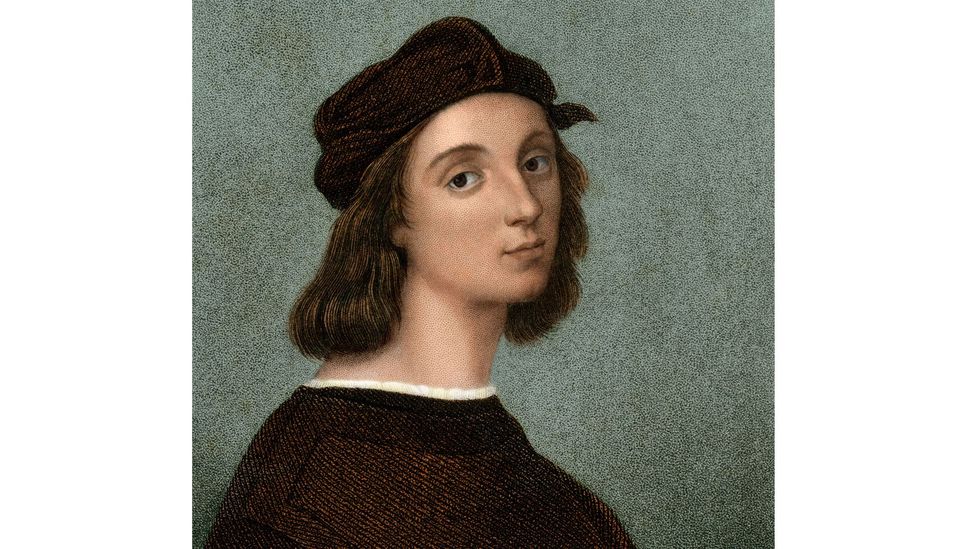
Raphael was in his mid-20s when Pope Julius II asked him to paint a fresco in the Vatican (Credit: Alamy)
Fresh from the ancient fortress city of Urbino where he was born and trained as an artist, Raphael was still in his mid-20s when, in 1509, Pope Julius II tapped him to assist in the redecoration of a suite of reception rooms in the Vatican’s Apostolic Palace. The artist’s celebrated contemporary, Michelangelo, had been brought in just a year earlier to take on the awesome task of designing and painting an elaborate scheme for the ceiling of the Sistine Chapel – the solemn space in which, a decade earlier, secretive conclaves of cardinals had begun to convene whenever a new pope was to be selected.
The first room that Raphael tackled was the Stanza Della Segnatura, or ‘Room of the Signature’, so-called as the location where the Church’s most significant documents were signed, sealed, and set into enforceable doctrine. The room also served as the Pope’s library and as the meeting place for The Supreme Tribunal of the Apostolic Signatura – the most powerful judicial body of the Catholic Church. Whatever colours and shapes, narratives and rhythms would ultimately adorn the four walls of this momentous chamber would oversee, if not potentially influence, some of the most consequential decisions affecting the lives (and afterlives) of all those who inhabited the sprawling Holy Roman Empire. The stakes could not have been higher, and Raphael knew it.
Who’s who?
With four large walls to fill and a reputation to secure, Raphael set about dedicating individual frescos to each of the four principal subjects that could be found in the Pope’s library: law, religion, literature, and philosophy. First up was a painting devoted to theology, followed quickly by one on the topic of poetry, entitled Parnassus, after the mountain where according to classical myth Apollo, the leader of the muses, resided. Limbered up, Raphael was ready to take on the discipline of philosophy, which he would exalt by summoning into a timeless space nearly two dozen influential thinkers across a millennium of intellectual speculation – from Anaximander (the 7th-Century BC exponent of all things infinite) to Boethius, the 6th-Century AD author of The Consolation of Philosophy.
But as Raphael began to create preparatory sketches for the ambitious fresco, a problem presented itself. How could any observer of his prospective painting be expected to distinguish one philosopher from another? A few short strides away from where he was working, Michelangelo was busy clambering on scaffold beneath the Sistine Chapel, conjuring from pigments and egg-wash a muscular who’s-who of Biblical heroes easily identifiable from their dramatic gestures and unique props. No one would ever mix up Noah’s rescuing of mankind from a great flood with God creating the planets. But Antisthenes from Xenophon? Diogenes from Sinope? Thinkers may think different thoughts, but their robes look remarkably the same.
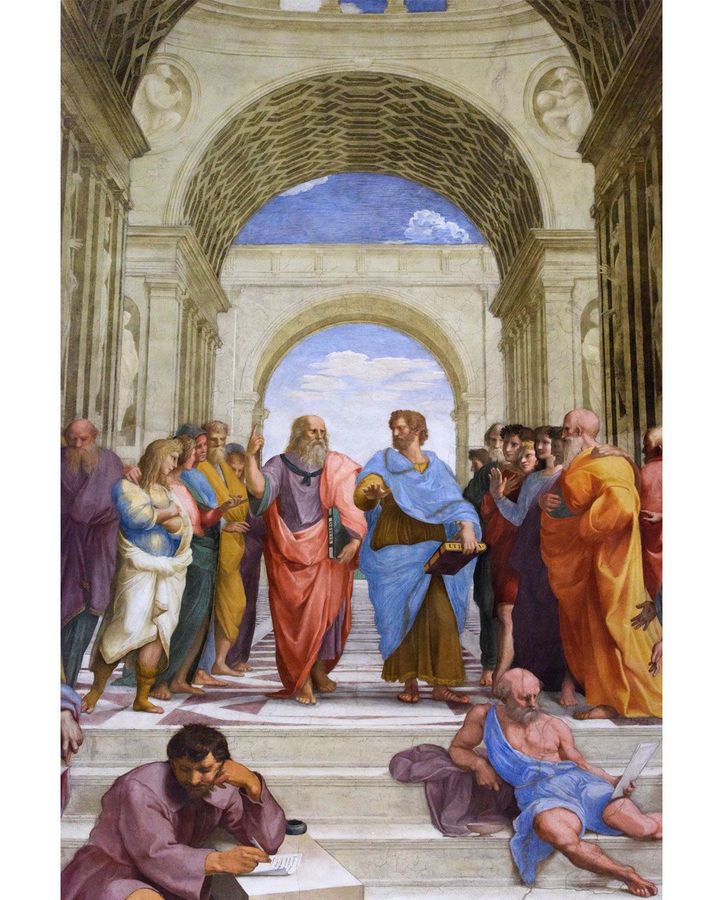
At first glance, Raphael has depicted Plato in a straightforward way, walking down steps next to Aristotle (Credit: Alamy)
As Raphael began to assemble his heady cast of anachronistic characters, the monumental muddle that might result must have seemed more and more pronounced. A puzzling throng of ambiguous figures splashing around in a soup of anonymous thought wouldn’t do. Sure, it might at first seem simple enough to tell the elder Plato from his student Aristotle, as the pair sashay in their scholarly way down the steps at the centre of the painting. After all, Plato is packing a copy of his treatise on the nature of man’s existence in the physical world, the Timaeus, while Aristotle awkwardly wields an instalment of his 10-volume Nicomachean Ethics. But forcing observers of the work to squint at the spine of hefty tomes shoved cumbersomely into the hands of each and every figure in the painting would have weighed the work down with tediously tweedy detail.
At some point in assembling his School, Raphael appears to have realised that establishing static and easily distinguishable identities for his celebrated students was the wrong approach. He should instead embrace the inevitable confusion, overtly invite a sense of irresolvable flux, and thereby make the indeterminacy of identity itself the very philosophy of his portrait of philosophy.
Look again at that depiction of Plato, and doesn’t his venerable visage and wizened beard rhyme uncannily with the countenance of Raphael’s esteemed elder contemporary, Leonardo Da Vinci, as captured in a well-known self-portrait of the renowned artist? And Plato’s hand, pointing upwards either towards heaven or to an idealised realm of transcendent oneness, hasn’t it gripped our eyes before in Leonardo’s own depiction of the disciple Thomas in The Last Supper, completed a decade earlier? Suddenly, Plato isn’t simply playing Plato. Instead, he embodies an intense compression of shifting personalities. In Raphael’s hands, he becomes a kind of lava lamp of identity in which the philosopher, the painter, and the epitome of doubting-all-you-see mingle and merge into one.
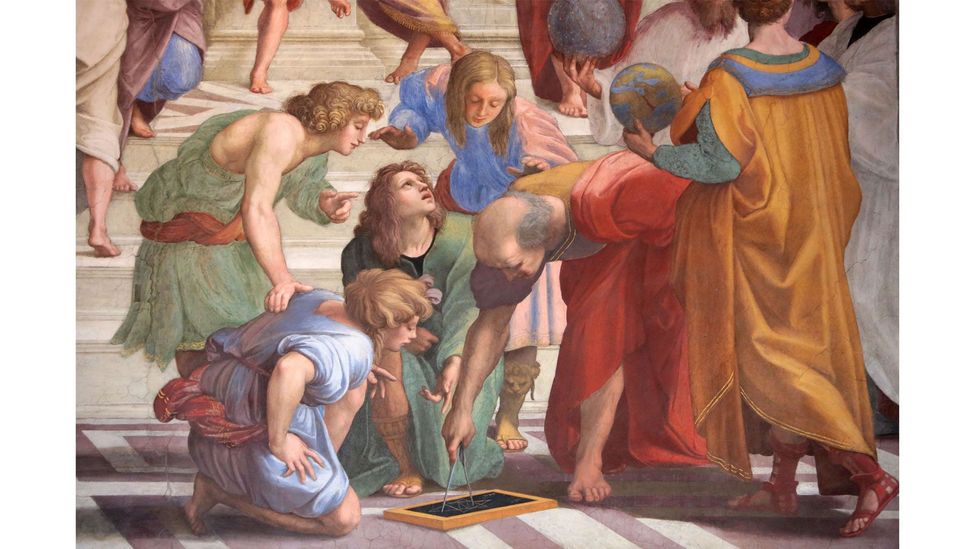
Many of the figures Raphael painted in the School of Athens could represent two different characters – was this ambiguity deliberate? (Credit: Alamy)
If you think that that complexity of persona is a one-off in the painting, consider the figure scribbling in a book in the left foreground of the fresco. Surely the tablet at his feet, on which a harmonic scale is scrawled, gives him away as Pythagoras. But who is that at his ear on his left? The postures and interaction of the two figures have credibly been identified by historians as a double portrait of St Matthew, accompanied – as he often is in iconography of the period – by an angel on his left side. And so the pattern of intertwinement repeats, portrait by portrait, across the surface of the fresco – the intriguing entanglement of identities.
Stunt doubles
On the right side, the draughtsman twiddling his compass has been compellingly identified as both Archimedes and Euclid. Your call. Or how about that gentleman in uniform who is being lectured by a short-snouted windbag to the right of Raphael’s Plato-Leonardo-Doubting Thomas composite? Some guides to the masterpiece will tell you he is Alexander the Great. Others say Alcibiades, the distinguished Athenian general. Elsewhere, the spirits of Strabo and of Zoroaster have been blended into a single likeness of an astronomer spinning an orb of stars as the bold blurring of identity ripples across the fresco.
But how do we know that any of this is intentional or part of the deliberate visual strategy of the painting? In order for Raphael’s fresco to work, the various spokes of twisting identity that comprise the stationary mobile of being must be tethered to a common axle – a hub among the hubbub that can help us make sense of the system. Then our eyes see it: that simple inkpot, unexpectedly rich and deep in symbolic implication. The object clearly belongs to the pensive writer whose quill has stalled mid-thought – a figure who is missing entirely from the preparatory sketches that Raphael had for the work. He was an afterthought – a final flourish added when the work was all but complete. Like the other palimpsests of personality that orbit around him, the figure has long been recognised as a hybrid of more than one historical figure across centuries. On the one hand, he is believed to be a tribute to Raphael’s revered rival Michelangelo, with whom his facial features remarkably rhyme. At the same time, his sulky air is synonymous with the dejected disposition of the pre-Socratic Greek philosopher Heraclitus.
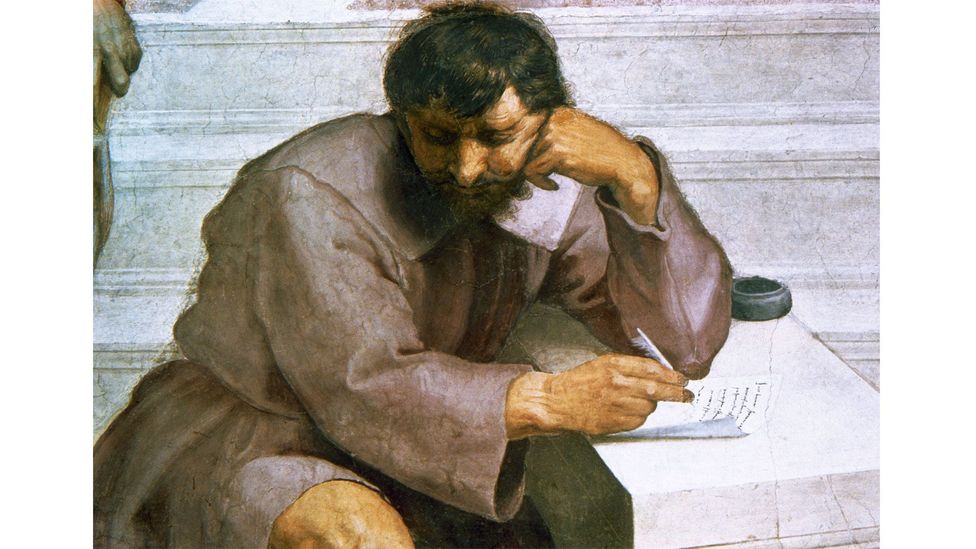
The writer in the painting is believed to be Michelangelo, but could equally be the Greek philosopher Heraclitus (Credit: Alamy)
That Raphael should make a last-minute allusion to Heraclitus, forever frozen in the act of composing his works, is telling and crucial to the coherence of his otherwise confounding fresco. Heraclitus is best known for his musings on the constant flux of the universe, famously crystallised in the assertion “you cannot step in the same river twice”. His certainty in the fleetingness of all things would be cruelly corroborated by the mists of time; not a single work of his has survived. By rewinding history to a moment when the very ink that memorialised the words of Heraclitus, who was known as ‘The Obscure’, was still wet, still un-nibbed, still unlost by time, Raphael imaginatively captures the ebb and flow of being.
As a symbol that oversees the enactment of official papal decrees in the Stanza Della Segnatura, Heraclitus’s ink pot (from which notions of the fleetingness of all authority would pour forth), is a courageously subversive symbol. It denies power by declaiming the futility of any attempt to inscribe oneself indelibly into the world. It and it alone sanctions the fluidity of identity that Raphael ingeniously constructs (and deconstructs) across the surface of his painting. Remove the inkpot from the epicentre of Raphael’s fresco, and the work dissolves into a fiasco of confused and confusing forms. Heraclitus’s profound, if overlooked, inkpot is the very well-spring from which the elastic energy of Raphael’s masterpiece endlessly emanates.
If you would like to comment on this story or anything else you have seen on BBC Culture, head over to our Facebook page or message us on Twitter.
And if you liked this story, sign up for the weekly bbc.com features newsletter, called The Essential List. A handpicked selection of stories from BBC Future, Culture, Worklife and Travel, delivered to your inbox every Friday.
